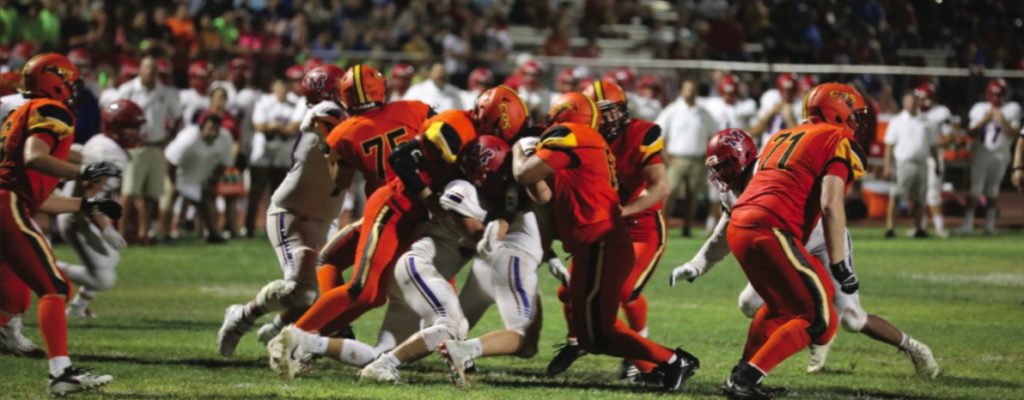
By Sammie Ann Wicks
It’s a sport that abounds with every heroic human metaphor—watching it, playing it—we glimpse humanity’s highest good cast on the world stage: where you fight to the end, ignore pain, play fair, support your teammates, protect your leader from attackers. All these give football its power to inspire the fanatical devotion it does on the national gridiron.
But what if you’re a mom (or a dad) and your teenager announces he wants to go out for his school’s football team?
This is every parent’s thorny conundrum, because, much as we love it, football has a potential for serious injury probably not equaled in any other sport—not tennis, not baseball, not even soccer.
After a career marked by a torn abdomen and shoulder, torn rib cartilage, severe joint sprains, concussions, a lacerated kidney and a current unresolved calf and ankle injury, Indianapolis Colts superstar Quarterback Andrew Luck in late August announced he’s quitting the game.
These are typical injury profiles for pro players. Fortunately for young players locally, however, the football field is far safer, thanks to the leadership of a Tempe sports administrator who knows a thing or two about the game.
“Nationally, these are very big men running very, very fast, so those kinds of contact injuries happen,” says Corona del Sol High School Assistant Principal and Athletic Director Cory Nenaber, himself the school’s longtime football coach.
“With high school kids, not so much.”
Nenaber says numerous protocols taken prior to participation in the sport, along with training
measures governing young players’ approach to play, help keep them safer, and still allow them to pursue a game they love.
“Unlike national pro ball, at our level we rarely see the pros’ kind of full body contact that can cause big injuries,” Nenaber declares. “This safer approach shows up in all kinds of ways.
“For instance, most of our intense drills are done with paddle dummies, things like that, that don’t result in injury.”
Nenaber adds that, once a student expresses a serious interest in playing football, he and his family must complete a series of preliminary qualifiers before he’s allowed to start training.
“Our district is working with the Arizona Interscholastic Association to provide concussion education and awareness to players and their families,” says Nenaber, adding, “while we also partner with other agencies to provide baseline concussion testing.”
First, Nenaber says a prospective student athlete “must complete an education and awareness online program…all on the student’s free time, either at home or at school.”
This requirement involves a simple computer-aided process.
“Here’s how it works,” explains Nenaber. “The athlete the tutorial, and takes a short test.”
At the end of this part of the procedure, the coach says the prospective athlete “prints the completion certification and turns it in to his or her coach.”
Nenaber stresses, however, that “all student athletes must complete the tutorial and submit a certificate before being cleared for practice or tryouts.”
After the required preliminaries, student athletes start training in modes that, particularly with football, show a philosophy of play that’s radically different from times past, or even from present-day pro venues.
“You’re not going to see young players today
executing helmet blocks, or body blocks like we’ve seen in the past—that leads to injury, and we’re just not coaching that way.”
Nenaber says today’s player-to-player contact is also significantly different from earlier times.
“So much of our modern coaching strives to eliminate head contact, either with another player or with the ground,” counsels Nenaber.
“It’s all about avoiding the use of the head in blocking, and instead using hand positions, engaging another player with the lower half of the body. These types of techniques, so different from earlier practices, have led to greater player safety.”
Nenaber stresses diagnostic protocols are immediately begun if an injury raises concerns about a concussion.
“Players with a possible injury are submitted to impact testing, and something we call ‘cognitive baseline testing,’ a neurological test that looks at response time and other factors,” he says. “If after that there are continued concerns, of course the player is referred to a doctor for evaluation.
“In all we do, concussions are at the forefront of our concern for high school players.” In other words, a far cry from football’s earliest free-for-all days when one massive human horde forcibly tried to push downfield past another.
Has the passion, the emotional intensity of the game, diminished in response to the plethora of new rules enacted to enhance player safety? Nenaber says no. “Even though the way football is played today is different from its wilder times, I do not see any decrease at all in the passion players have for this game.


